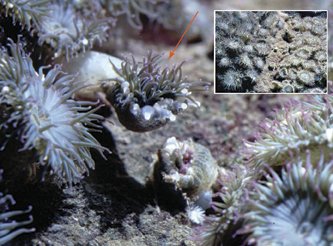Clone wars
Armies of sea anemones attack each other in raging wars.
By Emily Sohn
Sea anemones look like peaceful creatures. The squishy animals cling to rocks and wave their tentacles around. They grab whatever food comes along as the watery world passes by.
Anemones, however, aren’t as mellow as they might seem. Researchers have observed armies of anemones attacking each other in raging wars.
“Sea anemone fights are amazing,” says David Ayre of the University of Wollongong in Australia.
 |
|
An individual sea anemone (arrow) leans over to attack a small scout from the patch of clones next door. An empty zone (central swath in inset) separates patches of clones.
|
| Richard Grosberg |
Some 50 years ago, scientists noticed that certain anemones have special tentacles that aren’t used for capturing food. Called acrorhagi, these tentacles are used instead as weapons to sting enemy anemones. Certain individuals, called warriors, have lots of acrorhagi.
Some kinds of sea anemones live pretty much by themselves but a common kind, Anthopleura elegantissima, on the west coast of the United States sticks together in dense groups. Each member of a group has exactly the same DNA as every other member of the group, making them genetic clones of each other.
Researchers wanted to learn more about how anemones fight, but A. elegantissima are hard to study in the wild. So, the scientists toiled to move a big boulder with two groups of anemone clones into their lab. They had an aquarium built around it. The aquarium was regularly filled with water, and then emptied again to copy the action of tides.
When water rushed in after low tide in the aquarium, the researchers were surprised to find, warrior anemones near the border between the groups puffed up their acrorhagi, made their bodies three times longer than they were before, and started twisting around. They were able to reach out and sting foreign individuals that had crept too close.
The surprises didn’t stop there.
Anemone patches grow close to each other but usually leave an empty strip between them. Small anemones in the first row sometimes creep into this strip, ending up very close to the other patch.
One little critter that had crept into the empty zone, nicknamed Stumpy, endured such a strong attack that its own colony rejected it when it returned home. The researchers suggest that the attack covered Stumpy with so many foreign stinging cells that its own clones didn’t recognize it. Perhaps, they say, small anemones like Stumpy work as scouts in battle.
It’s a tough world out there—even for creatures that look as if they have a mellow lifestyle.—E. Sohn
Going Deeper:
Milius, Susan. 2005. Anemone wars: Clone armies deploy scouts, attack tidally. Science News 167(June 4):355-356. Available at http://www.sciencenews.org/articles/20050604/fob2.asp .
You can learn more about the sea anemone Anthopleura elegantissima at www.racerocks.com/racerock/eco/taxalab/wynnel.htm (Race Rocks, Lester B. Pearson College).







